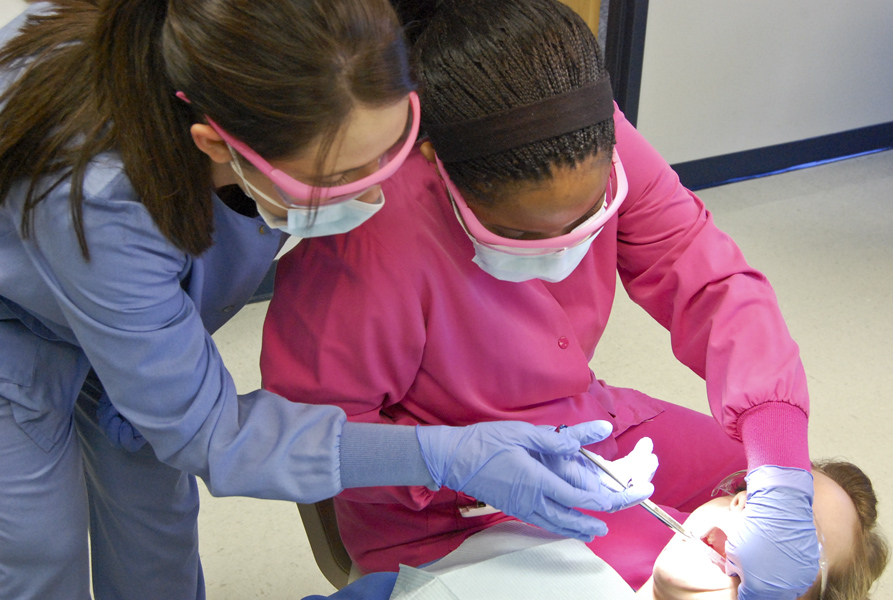Few people are as adept at giving shots as Jessie Mullins is at getting them. The Kellogg Community College sophomore has volunteered to be the test patient for more than 30 local anesthesia injections given by fellow students in the college’s dental hygiene program.
“I was nervous the very first time we did it,” Mullins says, looking relaxed as she lies in a dental chair preparing to receive the first of five maxillary injections from sophomore Briahna Mitchell.
Mitchell prepares her tray of instruments for the injections, going over the shots with an instructor and mimicking the movements of the procedure in Mullins’ mouth using the syringe, a cap on the needle.
“It’s not as bad once you start,” Mitchell says. “I was nervous, but it’s better after.”
Mullins opens wide as Mitchell leans over her body, syringe in hand, and eases the capless needle into her mouth. She depresses the syringe slowly, injecting clear anesthetic into Mullins’ gums, then eases the needle back out.
One down, four to go.
“It was fine,” Mullins says as Mitchell prepares for the next injection. “It just feels like pressure.”
A competitive advantage
Kellogg Community College has been offering instruction in local anesthesia for nearly 10 years, beginning shortly after Michigan law first allowed dental hygienists to administer the injections in 2002. Students learn about the procedures as part of a course they take in their final semester titled Pain Control, which also includes the administration of nitrous oxide.
Diana Bonfiglio, director of Allied Health and the supervising dentist at Kellogg Community College, says local anesthetic, which numbs specific areas within a patient’s mouth, is usually given to patients that are uncomfortable during the dental cleaning.
“Most of the time it’s given to the patients that have more involved disease of their tissues,” she says, noting periodontal disease. “We want to make them comfortable, and the anesthetic will numb up the area that we’re going to work in.”
Bonfiglio says her students start practicing the injections in the dental clinic within two weeks of starting the Pain Control class, initially practicing on tomatoes – “That was the closest thing I could come to that really felt like going through human tissue,” she says – before moving on to fellow students.
The students must complete 16 injections by graduation, two each of eight techniques to make sure they have experience giving the shots on both sides of the mouth. In order to be certified upon graduation, students must have passed the course as well as a board exam.
While it’s not required for hygienists to be certified in local anesthesia to work professionally, Bonfiglio says certification is a competitive advantage and is becoming more and more so.
‘I like to give them’
Local anesthesia can be serious business, no matter who it’s administered by, and Bonfiglio lists associated risks as including everything from bruising and tenderness at the site of the injection to anesthesia that can last longer than intended to, occasionally as long as a couple of years.
While Bonfiglio has seen some of that in private practice, she says, she’s seen little more serious than an occasional bruise from injections administered by her dental hygiene students. The side effects of the shots in her clinic are usually more lighthearted.
“Sometimes we’ll laugh just looking at people. You know, who looks the most like Elvis,” she says, curling her lip. “We try to make it as easy and fun as we can.”
She says when she hears concerns from first-year students related to the injections, it’s often a 50-50 split between those nervous about giving the injections and those nervous about getting them.
“There are some that are afraid to give it because they don’t want to do anything wrong or they don’t want to hurt somebody, and there’s the other half that are afraid to get the injection,” she says. “But I tell you, when they’re done I think they’ll all tell you that it was easier than they thought it was going to be and it was a lot better than they thought it would be.”
Sophomore Kim Trolz is among those who says she was more nervous about getting the shots than she was about giving them. Among her experiences administering the injections are three shots given to an actual patient, a man in his 20s unaffiliated with the program at Kellogg Community College.
Her experiences giving the shots has given her more confidence, even if her experiences getting them still makes her nervous.
“I volunteered for the injections as a first-year student to help minimize my anxiety, and it didn’t help,” Trolz says, laughing. “But I like to give them.”
In the above photo, from left to right, are Jamie Beale, RDH, co-director of Kellogg Community College’s Dental Hygiene Program; Briahna Mitchell; and Jessie Mullins.
For more information about the Dental Hygiene Program at Kellogg Community College, visit www.kellogg.edu/alliedhealth/dental. For photos from the recent dental hygiene pinning ceremony at the college, visit the college’s Facebook page at www.facebook.com/KelloggCommunityCollege/photos.
*Note: This article first appeared in the May 17 edition of the Battle Creek Shopper News and can be viewed online on page nine of the publication at http://issuu.com/ralphgushman/docs/shopper517.
